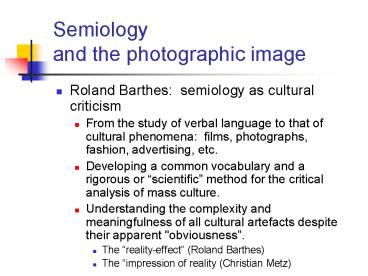Semiology and the photographic image PowerPoint PPT Presentation
1 / 21
Title: Semiology and the photographic image
1
Semiology and the photographic image
- Roland Barthes semiology as cultural criticism
- From the study of verbal language to that of
cultural phenomena films, photographs, fashion,
advertising, etc. - Developing a common vocabulary and a rigorous or
scientific method for the critical analysis of
mass culture. - Understanding the complexity and meaningfulness
of all cultural artefacts despite their apparent
"obviousness. - The reality-effect (Roland Barthes)
- The impression of reality (Christian Metz)
2
The photographic message the reality-effect
- The reality-effect
- So-called realism of the image makes it appear
to be "natural" rather than socially and
historically constructed. - A product or production of the image--its
structure of signification as a message. - The appeal to a belief
- I know very well that this is only a photograph,
yet I choose to believe in its reality. - Arguing that the photography functions as a sign
is to discredit it as an innocent or neutral
representation.
3
(No Transcript)
4
What is a sign?
- There is an arbitrary relation between a sign and
its meaning. - Referent what the signifier purports to
represent - Signifier representational aspect
- Signified concept or meaning
- If the relation between signifier and signified
is only defined by convention, then meaning or
signification is socially and historically
constructed.
5
Ferdinand de Saussure
6
The two traditions semiology and semiotics
- Semiology the study of signs based on
linguistics - Ferdinand de Saussure (1857-1913). Course on
General Linguistics. - Roland Barthes
- Christian Metz
- Semiotics the study of signs based on logic
- Charles Sanders Peirce (1839-1914)
- Umberto Eco
- Gilles Deleuze
7
Defining the sign representation
- The perceptible aspect of the sign how we
recognize the sign as standing for something - Saussure the signifier
- Peirce the representer or representamen
- Souriau the first degree of film form
8
Defining the sign representation
- Peirce icon, index, and symbol
- An icon signifies in virtue of its resemblance,
or its analogical relation to what it wishes to
represent. - A symbol does not resemble what it refers to it
signifies through the force of convention. - An index may but does not necessarily resemble
its referent. It signifies in virtue of a
relationship of contiguity with its referent. A
causal or existential link is presumed. - The representational character of signs can be,
and often is, mixed or heterogeneous.
9
(No Transcript)
10
Defining the sign signification
- How signs become meaningful to individuals and
societies. - Saussure the signified
- Peirce the interpretant
- Souriau the second degree of film form
- Signification is always defined by convention.
- The distinction between speech (parole) and
language (langue).
11
Defining the sign signification
- The distinction between speech (parole) and
language (langue). - Speech the everyday use of language. A
potentially infinite number of statements. - Language the limited number of rules we use in
speaking. - The distinction between message and code.
12
Defining the sign signification
- The message is
- actual
- concrete
- singular
- heterogeneous
- A code is
- ideal
- abstract
- general
- homogenous
13
Defining the sign signification
- A message is a singular, meaningful unit of
discourse. - A code is an abstraction created by the
analyst--a logic reconstructed from the materials
provided by the message. - A code is a principle of intelligibility
formulated by the film theorist through the
analysis of specific "messages." - Its unity or homogeneity is not of a sensory or
material order rather, it is an order of logical
coherence, valued for its explanatory power.
14
(No Transcript)
15
Roland Barthes on photography
- The photographic message
- a sign can be a very complex structure that mixes
forms and materials of representation - a sign is meaningful only in context.
- Denotation and connotation
- The photographic paradox
- The photograph is a message without a code.
16
The photograph is a message without a code
17
Roland Barthes on photography
- The denotation of the photograph
- "Certainly the image is not the reality but at
least it is its perfect analogon and it is
exactly this analogical perfection which, to
common sense, defines the photograph (17). - The photograph as a "mechanical analogon" whose
message is "the scene itself, literal reality." - The photographic paradox
- The spectators fascination with "the here-now,
for the photograph is never experienced as an
illusion ..., its reality is that of the having
been there, for in every photograph there is
always the stupefying evidence of this is how it
was, giving us, by a precious miracle, a reality
from which we are sheltered" (44).
18
Roland Barthes on photography
- The code gravitates toward connotational meaning.
- The imposition of a second meaning through
editorial choice, laboratory manipulations,
cropping, layout, etc. - The informational or "obvious" meaning of the
photograph. - Connotation is to denotation as a caption or
written text is to the photograph. - If the message is "informational" then the code
structures the "symbolic" level of meaning, that
is, the range of meanings accruing to the image
in virtue of conventional or cultural
associations.
19
(No Transcript)
20
Roland Barthes on photography
- Ideology and the image
- How the image structures social belief and
meaning - The ideological function of connotation, as
regulated by given codes, is to reassure
individuals and to integrate them into the
society overall. - How the image is naturalized by the code.
- The traumatic quality of the photograph as a
suspension of language
21
(No Transcript)

